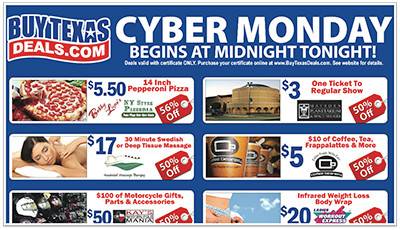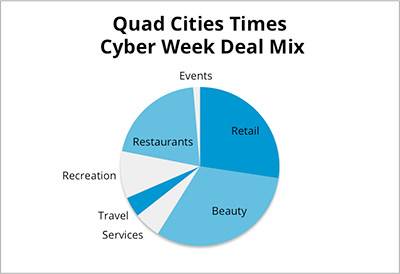How every site can make money with ecommerce promotions


Matt Coen
Ecommerce promotions are transactional in nature, and the goal is to drive sales on your site that also offers great value to your audience.
Ecommerce models have been steadily evolving as people spend more of their time and money online. While running a successful daily deals program requires resources and effort to have huge revenue potential, there are many alternate approaches you can pursue to drive revenue for your paper.
If you have a successful daily deal program, the ideas below can be added to your program to generate new digital revenue. If you're looking for a way to get into ecommerce and diversify your digital revenue, there are plenty of other options that can work for you, too.
So what are the options newspapers have when it comes to ecommerce promotions?
- Daily deals. You have a site where you are running 7+ deeply discounted deals each week. A daily deals program requires commitment, but they are still incredibly successful for many media companies across the country. Plus, individual deals are also capable of bringing in standout revenue – like the Provo Daily Herald Stadium of Fire event deal that generated $95,000.
- Cards. Since cards include multiple offers sold together, they are sold at higher price points and yield a higher return on your investment. These offers can either be multiple offers from the same merchant – like a variety of services at a spa – or the same offer from a variety of merchants – like a round of golf at a number of courses in the area. Examples of the kind of revenue cards can drive for programs of all types are prevalent:
- WISE & WPTA-TV's multi-merchant golf card generated $112,000, and customers were clamoring for more.
- A single-merchant spa card brought in $12,000 for the small-market State College Centre Daily Times (it was so popular that it sold out – twice)!
- A single-merchant spa card from UpNorthLive.com drove $16,000 and sold out within 11 hours.
- Big weekly offer. You have a site where you run only one great offer each week. These tend to be better deals for higher-quality merchants. Since you can run only 52 deals per year with this model, there is a certain level of exclusivity.
- Exclusive offer. These exclusive, high-value deals that can either be run as standalone promotions or as a complement to either type of program described above. When you are selecting merchants for these promotions, think experiential and special, like a five-course meal prepared by a well-known chef, a private jet ride, a weekend away at a high-end resort, and so on. When you are marketing these deals, focus less on the discount and more on the valuable, unique experience.
- Stores. A store is a themed collection of deals run around a holiday, season or special event. These can include a broader range of deals than would be a good fit for a regular daily or weekly program. You can either temporarily turn your existing deals site into a themed store, or run the store as a standalone in addition to your regular schedule. Quad-City Times runs an incredibly successful Cyber Week deals store every year (it has generated more than $154,000 in a week – more than doubling the paper's November revenue from ecommerce promotions), and the Miami Herald drove $116,000 with a Best Of store featuring repeats of their top-selling deals from the year.
- Theme weeks. If you have a group of themed deals that don't warrant a full deals store, you can still make an event out of it by creating a week-long site theme with special branding and promotion. A site theme can work any time of year, not just around a holiday – consider themes like deals for kids, summer deals, or even barbecue restaurant deals! However, site themes still work well during the holidays. Killeen Daily Herald, a small-market paper in Killeen, Texas, brought in more than $15,000 with a week-long "Last Minute Gifts" site theme in December.
 |
- Progressive discounting. This is a twist on a regular deal, where the discount starts small and deepens every day until it reaches 50 percent or the deal sells out, whichever comes first. On the Monday the deal launches, the discount might be 10 percent, which would deepen to 20 percent on Tuesday, 30 percent on Wednesday, 40 percent on Thursday, and so on. These are great as tie-ins with core media promotions, and they typically run for a week. This type of offer is a BIG event, so consider running a promotion like this a few times a year.
While the models described above can all be standalone initiatives (especially stores and cards), they can also all be combined and layered to generate even more revenue. You could use an exclusive offer to attract people to your site, which is then also stocked with smaller side deals for people to browse. You could include a card in a themed store.
Depending how many resources you want to put into your ecommerce program, the sky's the limit for revenue. Quad-City Times is running daily deals, stores, and cards, and the paper brought in $2 million from ecommerce promotions in 2013!
 |
When it comes to ecommerce promotions, you have a menu of options and it's up to you to decide what kind of program you want and how many resources you can devote to it. Ecommerce will only continue to grow especially as more local businesses get on-board. The bottom line is that ecommerce promotions ALL make money and can ALL bring in incremental digital revenue.
Matt Coen is the president and co-founder of Second Street, a leading provider of private-label online promotions platforms and partner success services for media companies based in St. Louis, Mo. He can be reached at (314) 880-4902 or matt@secondstreet.com.





